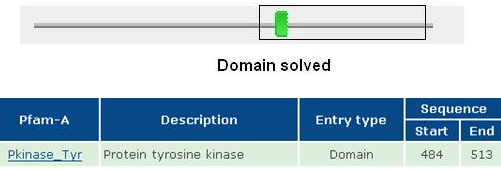|
|
GSG2: Germ cell associated 2 (Haspin) kinase
2VUW: Eswaran, J., Murray, J.W., Filippakopoulos, P., Soundararajan, M., Pike, A.C.W., Von Delft, F., Picaud, S., Keates, T., King, O., Muller-Knapp, S., Lee, W.H., Marsden, B.D., Wickstroem, M., Bountra, C., Edwards, A.M., Arrowsmith, C.H., Fedorov, O., Burgess-Brown, N., Bray, J., Knapp, S.
3DLZ: Filippakopoulos, P., Eswaran, J., Keates, T., Burgess-Brown, N., Murray, J.W., Von Delft, F., Muller-Knapp, S., Lee, W.H., Marsden, B.D., Arrowsmith, C.H., Edwards, A.M., Wickstroem, M., Bountra, C., Knapp, S.
3F2N: Filippakopoulos, P., Eswaran, J., Keates, T., Burgess-Brown, N., Fedorov, O. Yue, W.W., Murray, J.W., Pike, A.C.W., Von Delft, F., Muller-Knapp, S., Lee, W.H., Marsden, B.D., Arrowsmith, C.H., Edwards, A.M., Weigelt, J., Bountra, C. Knapp, S.
3E7V: Filippakopoulos, P., Eswaran, J., Keates, T., Burgess-Brown, N., Fedorov, O., Pike, A.C.W., Von Delft, F., Muller-Knapp, S., Lee, W.H., Marsden, B.D., Arrowsmith, C.H., Edwards, A.M., Wickstroem, M., Bountra, C., Knapp, S.
PDB Codes:
2VUW (deposited on 30.May.08)
3DLZ (deposited on 30.Jun.08)
3E7V (deposited on 19.Aug.08)
3F2N (deposited on 30.Oct.08)
Datapack version: 1 (built on 24.Nov.08; last revised in 27.Feb.09)
Quick Facts
|
SGC target ID |
GSG2A |
||||||||||||||||||||||||||||||||||||||||||||
|
QUICK FACTS |
Haspin, Germ cell associated 2 (haspin), Haploid germ cell specific nuclear protein kinase |
||||||||||||||||||||||||||||||||||||||||||||
|
Updated |
28. Apr. 08 |
||||||||||||||||||||||||||||||||||||||||||||
|
Domain Structure acc. to Pfam |
|
||||||||||||||||||||||||||||||||||||||||||||
|
Protein Size |
88.50 kDa |
||||||||||||||||||||||||||||||||||||||||||||
|
#residues |
798 aa |
||||||||||||||||||||||||||||||||||||||||||||
|
Contact info. |
Name: Stefan Knapp
|
||||||||||||||||||||||||||||||||||||||||||||
|
Entrez Gene |
|||||||||||||||||||||||||||||||||||||||||||||
|
cDNA available? |
Synthetic |
||||||||||||||||||||||||||||||||||||||||||||
|
Gene sequence |
|||||||||||||||||||||||||||||||||||||||||||||
|
Protein sequence |
|||||||||||||||||||||||||||||||||||||||||||||
|
Biochemical function |
|
||||||||||||||||||||||||||||||||||||||||||||
|
Biological function |
|
||||||||||||||||||||||||||||||||||||||||||||
|
Human mutations |
|
||||||||||||||||||||||||||||||||||||||||||||
|
Mouse models |
Not yet available but depletion of haspin by RNAi causes misalignment of metaphase chromosomes |
||||||||||||||||||||||||||||||||||||||||||||
|
Summary role in disease |
|
||||||||||||||||||||||||||||||||||||||||||||
|
Closest sequence Matches (10 or less) |
29. Apr.08
|
||||||||||||||||||||||||||||||||||||||||||||
|
Closest match in PDB |
29. Apr.08
Attention.: full-length:798 residues; matches found only for the C-terminal kinase domain, ranging from ~200 to ~400 residue |
||||||||||||||||||||||||||||||||||||||||||||
|
Splice forms |
|
||||||||||||||||||||||||||||||||||||||||||||
|
ProSite hits |
|
||||||||||||||||||||||||||||||||||||||||||||
|
Protein, expression/ Localization |
|
||||||||||||||||||||||||||||||||||||||||||||
|
Gene expression |
|
||||||||||||||||||||||||||||||||||||||||||||
|
Substrates/ cofactors/ inhibitors |
|
||||||||||||||||||||||||||||||||||||||||||||
|
Interacting proteins |
|
||||||||||||||||||||||||||||||||||||||||||||
|
Posttranslational modifications |
|
||||||||||||||||||||||||||||||||||||||||||||
|
Key references |
|||||||||||||||||||||||||||||||||||||||||||||
|
Other comments |
Haspin-like proteins have a complete but divergent eukaryotic protein kinase domain sequence. Haspin-related proteins lack conservation of a subset of residues that are almost invariant in known kinases and possess distinctive inserted regions. Haspin-like proteins are identified in several major eukaryotic phyla-including yeasts, plants, flies, fish, and mammals-and an extended group in Caenorhabditis elegans. Haspin protein contains a basic region, a leucine zipper and MEFB2 homologous region in a addition to the kinase domain. Human and murine proteins are 83% identical in the C-terminal kinase domain, but only 53% identical in the N-terminal region. The Gsg2 gene is intron less and located in the intron of the alpha E2 integrin gene. |

